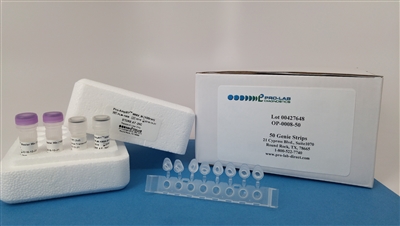Description
*COLD SHIP ITEM: NEXT DAY DELIVERY REQUIRED WHEN SELECTING SHIPPING METHOD
This Pro-AmpRT™ isothermal amplification kit allows fluorescence detection of West Nile Virus (WNV) on the Genie® II and Genie III platforms but may also be used on generic qPCR instrumentation. Detection results completed in about 7 minutes. An anneal curve can then be generated to confirm the product. This eliminates the need for gel electrophoresis or turbidity detection and allows for a closed-tube system. Isothermal Mastermix can be used with RCA, SMAP and many other amplification technologies.
PUBLICATION : https://www.ncbi.nlm.nih.gov/pubmed/29462341
Format: Abstract
J Med Entomol. 2018 Feb 15. doi: 10.1093/jme/tjy005. [Epub ahead of print]
Laboratory Evaluation of Commercially Available Platforms to Detect West Nile and Zika Viruses From Honey Cards.
Abstract
Commercially available assays utilizing antigen or nucleic acid detection chemistries provide options for mosquito control districts to screen their mosquito populations for arboviruses and make timely operational decisions regarding vector control. These assays may be utilized even more advantageously when combined with honey-soaked nucleic acid preservation substrate ('honey card') testing by reducing or replacing the time- and labor-intensive efforts of identifying and processing mosquito pools. We tested artificially inoculated honey cards and cards fed upon individually by West Nile virus (WNV) and Zika virus (ZIKV)-infected mosquitoes with three assays to compare detection rates and the limit of detection for each platform with respect to virus detection of a single infected mosquito and quantify the time interval of virus preservation on the cards. Assays evaluated included CDC protocols for real-time reverse transcriptase polymerase chain reaction (RT-PCR) for WNV and ZIKV, Pro-Lab Diagnostics ProAmpRT WNV loop-mediated amplification (LAMP) and ZIKV LAMP assays, and the Rapid Analyte Measurement Platform (RAMP) WNV assay. Real-time RT-PCR was the most sensitive assay and the most robust to viral RNA degradation over time. To maximize the detection of virus, honey cards should be left in the traps ≤1 d if using LAMP assays and ≤3 d if using real-time RT-PCR to detect viruses from field samples. The WNV RAMP assay, although effective for pool screening, lacks sensitivity required for honey card surveillance. Future studies may determine the minimum number of infectious mosquitoes required to feed on a honey card that would be reliably detected by the LAMP or RAMP assays.
